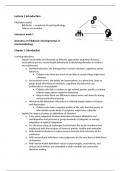Samenvatting
Summary Alle literatuur en hoorcolleges developmental psychopathology
- Vak
- Instelling
- Boek
Dit bestand bevat alle hoorcolleges en verplichte literatuur van het vak developmental psychopathology van de Universiteit Utrecht. De literatuur die behandelt wordt in dit document: - Uitgebreide samenvatting boek Parritz & Troy 4de editie - Crompton, C., DeBrabander, K., Heasman, B., Milton, D...
[Meer zien]













